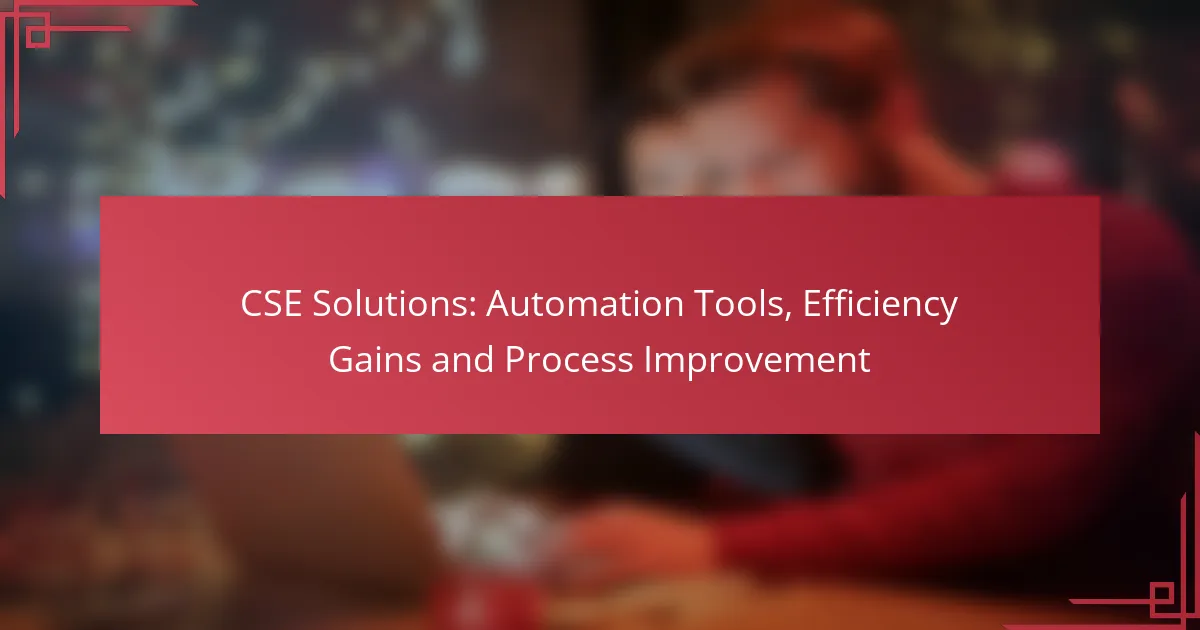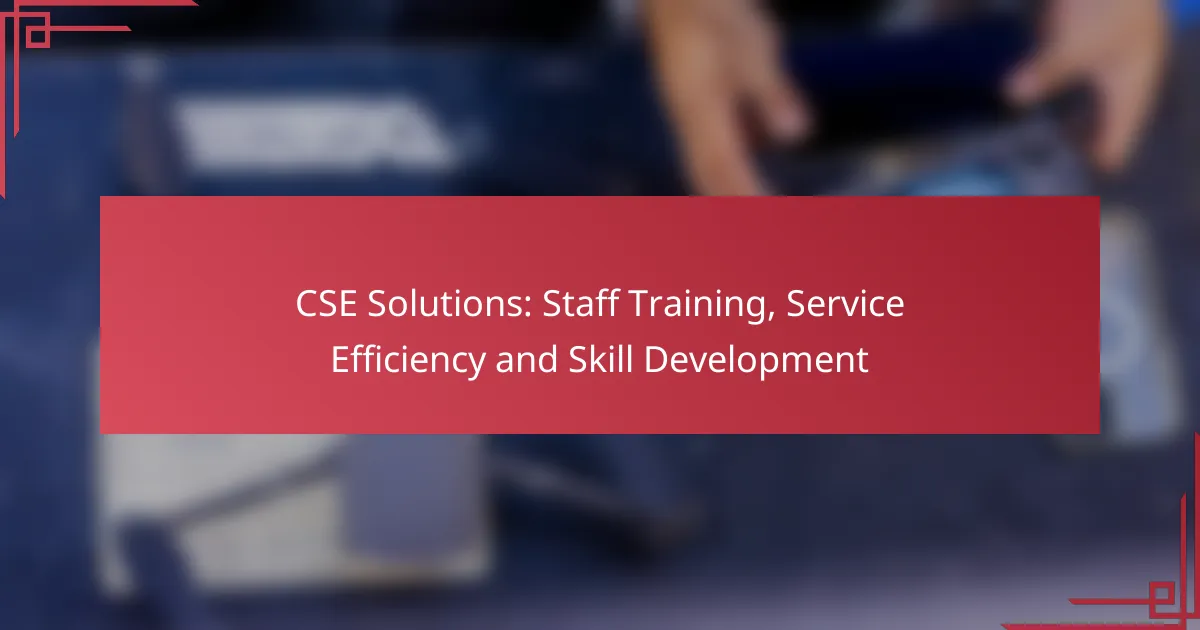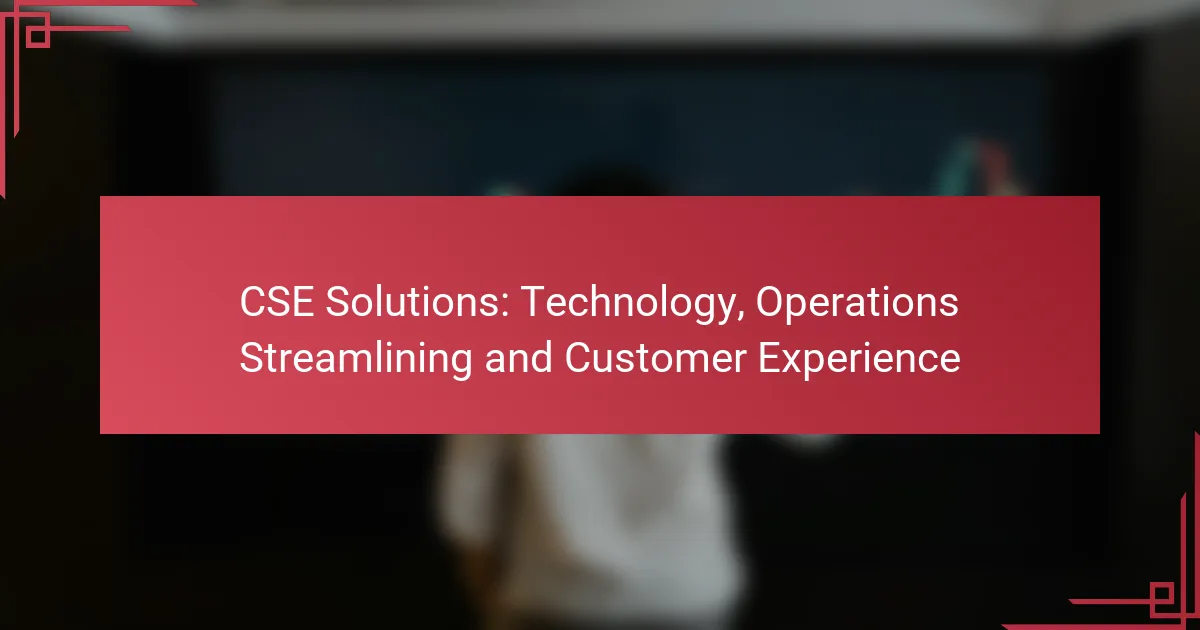CSE solutions leverage advanced automation tools like UiPath, Automation Anywhere, and Blue Prism to significantly enhance operational efficiency. By automating repetitive tasks and optimizing workflows, these tools not only reduce errors but also enable teams to concentrate on strategic initiatives. Implementing Continuous Software Engineering practices leads to measurable improvements in productivity and resource allocation, driving overall performance gains for organizations.

What are the best CSE automation tools in the UK?
The best CSE automation tools in the UK include UiPath, Automation Anywhere, and Blue Prism. These tools enhance efficiency through robotic process automation, cloud automation, and enterprise-level solutions, catering to various business needs.
UiPath for robotic process automation
UiPath is a leading tool for robotic process automation (RPA), enabling businesses to automate repetitive tasks efficiently. It allows users to create software robots that can mimic human actions across various applications, significantly reducing manual effort.
When implementing UiPath, consider its user-friendly interface and extensive library of pre-built automation components. This can lead to quicker deployment and lower training costs. However, ensure that your team is prepared for ongoing maintenance and updates to the automation processes.
Automation Anywhere for cloud automation
Automation Anywhere specializes in cloud automation, providing a flexible platform that can scale with your business. It offers a range of tools that facilitate the automation of workflows and processes in cloud environments, making it suitable for organizations transitioning to cloud-based operations.
Utilizing Automation Anywhere can lead to improved collaboration and integration across different systems. However, businesses should assess their cloud security measures and compliance with regulations, especially if handling sensitive data.
Blue Prism for enterprise-level automation
Blue Prism is designed for enterprise-level automation, focusing on scalability and security. It allows large organizations to automate complex processes while maintaining governance and compliance standards, making it ideal for industries such as finance and healthcare.
When choosing Blue Prism, consider its robust security features and ability to integrate with existing IT infrastructure. However, the initial setup may require significant investment in terms of time and resources, so ensure you have a clear strategy for implementation and support.

How can CSE solutions improve efficiency?
CSE solutions enhance efficiency by automating repetitive tasks, optimizing workflows, and reducing errors. This leads to faster processes and allows teams to focus on more strategic activities.
Streamlined workflows
Streamlined workflows result from the integration of CSE solutions, which automate routine tasks and eliminate unnecessary steps. For example, using automated data entry can significantly reduce the time spent on manual input, allowing employees to allocate their time to higher-value tasks.
To achieve streamlined workflows, organizations should assess their current processes and identify bottlenecks. Implementing tools that facilitate collaboration and communication can also enhance workflow efficiency, ensuring that all team members are aligned and informed.
Reduced operational costs
CSE solutions can lead to reduced operational costs by minimizing manual labor and decreasing the likelihood of errors that require costly corrections. By automating processes, companies can lower labor expenses and improve resource allocation.
For instance, businesses that adopt automated customer support systems often see a decrease in staffing costs while maintaining high service levels. It’s crucial to analyze the return on investment (ROI) of these solutions to ensure that the savings outweigh the initial implementation costs.
Enhanced data accuracy
Enhanced data accuracy is a significant benefit of CSE solutions, as automation reduces human error in data handling. Accurate data is essential for informed decision-making and can improve overall business performance.
To maximize data accuracy, organizations should implement validation checks within their automated systems. Regular audits and updates of data management practices can further ensure that the information remains reliable and up-to-date, supporting better operational outcomes.

What are the key benefits of process improvement with CSE?
Process improvement with CSE (Continuous Software Engineering) offers significant advantages, including enhanced efficiency, streamlined workflows, and optimized resource allocation. By implementing automation tools and methodologies, organizations can achieve measurable gains in productivity and overall performance.
Increased productivity
One of the primary benefits of process improvement is increased productivity. By automating repetitive tasks, teams can focus on higher-value activities, leading to more output in less time. For example, automating testing processes can reduce the time spent on manual testing by up to 80%, allowing developers to release updates more frequently.
To maximize productivity gains, organizations should identify bottlenecks in their workflows and target those for automation. Regularly reviewing processes can help maintain efficiency and adapt to changing demands.
Faster decision-making
Process improvement enables faster decision-making by providing teams with timely and accurate data. Automation tools can aggregate and analyze data in real-time, allowing stakeholders to make informed choices quickly. For instance, using dashboards that display key performance indicators can help managers assess project health at a glance.
To enhance decision-making speed, organizations should ensure that their data sources are integrated and accessible. Establishing clear protocols for data usage can also streamline the decision-making process and reduce delays.
Better customer satisfaction
Improving processes directly contributes to better customer satisfaction by enhancing the quality and speed of service delivery. When organizations streamline their operations, they can respond to customer inquiries and issues more promptly, leading to higher satisfaction rates. For example, automating customer support through chatbots can provide instant responses to common queries.
To ensure customer satisfaction remains high, businesses should regularly gather feedback and adjust their processes accordingly. Implementing a continuous improvement mindset can help organizations stay responsive to customer needs and preferences.

What criteria should you consider when selecting CSE solutions?
When selecting CSE solutions, consider integration capabilities, scalability options, and vendor support. These criteria ensure that the tools you choose will effectively enhance your processes and adapt to your organization’s needs.
Integration capabilities
Integration capabilities refer to how well the CSE solutions can connect with your existing systems and tools. Look for solutions that offer APIs and support for popular software platforms to streamline workflows and data sharing.
Consider the ease of integration as well. Solutions that require minimal customization or have pre-built connectors can save time and reduce implementation costs. Evaluate whether the tool can seamlessly integrate with your CRM, ERP, or other essential systems.
Scalability options
Scalability options determine how well a CSE solution can grow with your organization. Choose tools that can handle increasing volumes of data and users without sacrificing performance. This flexibility is crucial as your business expands.
Assess whether the solution can be easily upgraded or if it offers tiered pricing models. A solution that allows you to start small and scale up as needed can be more cost-effective in the long run.
Vendor support and training
Vendor support and training are critical for ensuring successful implementation and ongoing use of CSE solutions. Evaluate the level of customer support offered, including response times and availability of resources such as documentation and tutorials.
Consider training options as well. Comprehensive training programs can help your team quickly adapt to the new tools, maximizing efficiency gains. Look for vendors that provide ongoing support and updates to keep your system running smoothly.

What are the common challenges in implementing CSE solutions?
Implementing CSE (Customer Service Excellence) solutions often faces several challenges that can hinder their effectiveness. Key issues include resistance to change, data security concerns, and high initial investment costs.
Resistance to change
Resistance to change is a significant barrier when adopting CSE solutions. Employees may be accustomed to existing processes and hesitant to embrace new technologies or methodologies, fearing disruption to their workflow.
To mitigate this resistance, organizations should involve staff in the decision-making process and provide comprehensive training. Clear communication about the benefits of CSE solutions can also help ease concerns and foster a more positive attitude towards change.
Data security concerns
Data security concerns are paramount when implementing CSE solutions, especially with sensitive customer information at stake. Organizations must ensure that any new systems comply with relevant regulations, such as GDPR in Europe or CCPA in California.
To address these concerns, businesses should conduct thorough risk assessments and choose solutions with robust security features. Regular audits and employee training on data protection practices can further enhance security measures.
High initial investment
The high initial investment required for CSE solutions can deter organizations from proceeding with implementation. Costs may include software purchases, hardware upgrades, and training expenses, which can add up quickly.
Organizations should consider the long-term benefits and potential return on investment (ROI) when evaluating these costs. Exploring financing options or phased implementations can help spread out expenses and make the transition more manageable.

How can businesses in London leverage CSE for growth?
Businesses in London can leverage CSE (Customer Service Excellence) to drive growth by enhancing automation tools, improving efficiency, and refining processes. By focusing on these areas, companies can streamline operations, reduce costs, and elevate customer satisfaction.
Automation Tools
Automation tools are essential for businesses looking to enhance their customer service capabilities. These tools can handle repetitive tasks, such as responding to common inquiries or processing orders, allowing staff to focus on more complex customer needs. Popular automation solutions include chatbots, automated email responses, and customer relationship management (CRM) systems.
When selecting automation tools, consider factors like ease of integration with existing systems, scalability, and user-friendliness. For instance, a chatbot can significantly reduce response times, often providing answers in seconds rather than minutes, which can lead to higher customer satisfaction.
Efficiency Gains
Efficiency gains can be achieved by optimizing workflows and reducing bottlenecks in customer service processes. This can involve analyzing current procedures to identify areas for improvement, such as streamlining communication channels or enhancing staff training. For example, implementing a centralized ticketing system can help track customer inquiries more effectively.
Businesses should regularly review their performance metrics to measure efficiency improvements. Key performance indicators (KPIs) like average response time and customer satisfaction scores can provide insights into how well processes are functioning and where further adjustments may be needed.
Process Improvement
Process improvement focuses on refining customer service operations to enhance overall performance. Techniques such as Lean and Six Sigma can be applied to eliminate waste and improve service delivery. For example, mapping out the customer journey can reveal pain points that need addressing, such as long wait times or unclear communication.
To implement process improvements effectively, involve team members in brainstorming sessions to gather diverse perspectives. Regular feedback loops with customers can also guide adjustments, ensuring that changes align with customer expectations and enhance their experience.



